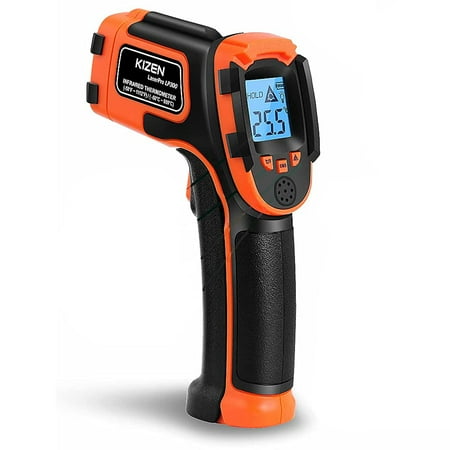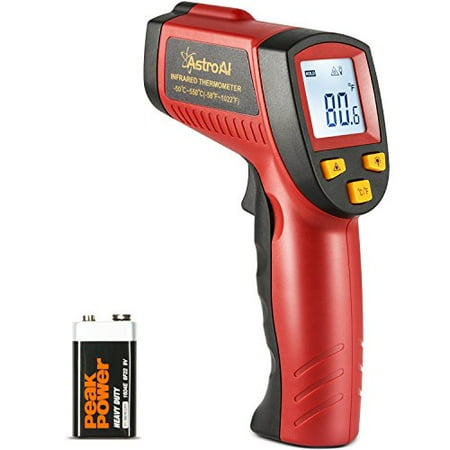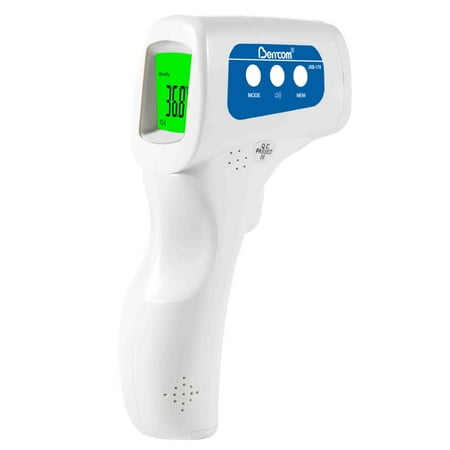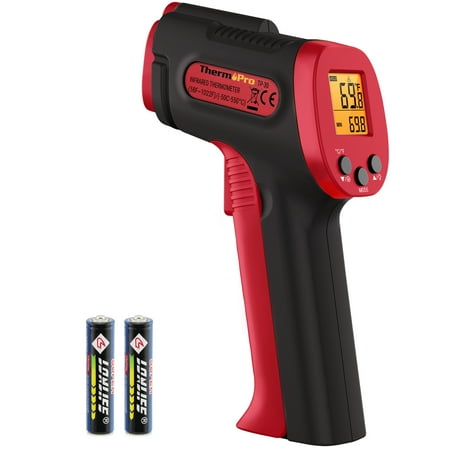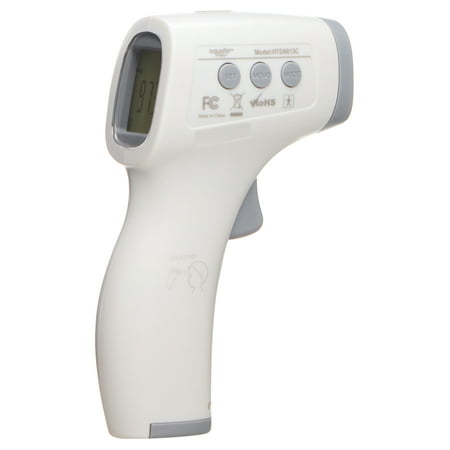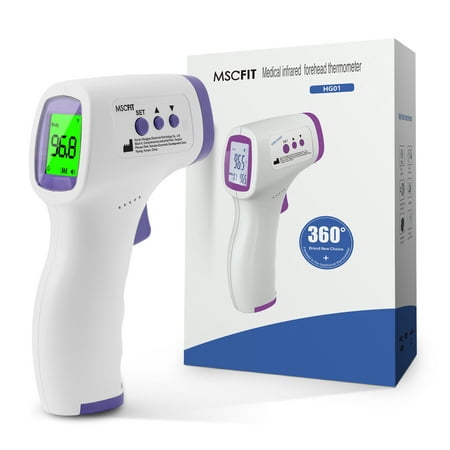Have you ever had an experience in which you needed to measure the temperature of something quickly and accurately?
If so, you may have encountered a situation that would benefit from using an infrared thermometer.
This device is a handy tool for measuring temperatures without direct contact with whatever is being tested – making it ideal for situations where physical touch may not be possible or desirable. This article will explain precisely how infrared thermometers work and explore some of their most common uses.
Infrared thermometers are devices designed to measure the surface temperature of objects without having any physical contact with them. They do this by using particular detectors to detect radiation emitted by the object’s surface and convert it into a temperature reading.
These readings are often highly accurate, especially compared to traditional methods like mercury-in-glass thermometers. Additionally, they can take measurements far more quickly than these older methods, making them invaluable in many scenarios where speed is essential.
Finally, because of their wide range of applications, infrared thermometers have become increasingly popular in the manufacturing, engineering, and food preparation industries.
From monitoring process temperatures during industrial processes to ensuring food safety standards are met in restaurants, there are countless ways in which these devices can be used effectively – all with minimal effort required from those handling them!
In the following sections, we’ll discuss some of the most common uses for infrared thermometers today – so read on to learn more about what these remarkable tools can accomplish!
Review contents
Definition Of An Infrared Thermometer
An infrared thermometer is a device that measures the temperature of an object without needing to make physical contact.
It does this by using infrared (IR) radiation, or in other words, heat energy from the surface of an object. This makes it useful for measuring temperatures in hazardous areas or where direct contact with hot surfaces can be dangerous.
The IR thermometer works by detecting and focusing on small amounts of the IR radiation emitted from the surface of the object being measured.
The sensor then converts this focused energy into a temperature reading displayed on its LCD screen. Modern digital versions can even take readings over long distances, making them highly versatile tools.
This type of thermometer has many applications across different industries and fields, including medical, laboratory research, industrial maintenance, manufacturing processes, and food preparation activities such as grilling and baking.
Basics Of Temperature Measurement
Now that we understand an infrared thermometer let’s look at the basics of temperature measurement. Temperature measures how hot or cold something is relative to its environment.
It can be measured in many ways, but one of the most common uses for an infrared thermometer is to measure surface temperatures without contact. This means it can be used on objects and surfaces without touching them, making it perfect for industries such as automotive repair and food processing, where sanitation and safety are essential.
Infrared thermometers use light energy from infrared radiation emitted by objects to determine their temperature. The device then measures this incoming light energy and converts it into a temperature reading displayed on the screen.
As a non-contact method of measuring temperature, they offer several benefits over other instruments, including accuracy, efficiency, and convenience.
They can also be used in areas where traditional methods may not work, such as assessing high temperatures in hazardous environments like power plants and smelters without putting workers at risk.
Infrared thermometers are also commonly used in medical treatments, research laboratories, and industrial processes like welding to ensure quality control and process optimization.
Benefits Of An Infrared Thermometer
An infrared thermometer offers many benefits in both industrial and medical settings. Its non-contact usage allows for accurate temperature readings without the risk of contamination, making it ideal for use in areas where hygiene is a priority.
Additionally, its quick response time makes it suitable for measuring rapidly changing temperatures on moving objects or surfaces that are difficult to access with traditional methods.
Infrared thermometers also can detect slight temperature differences between objects. This can be useful when measuring heat loss from buildings and monitoring equipment performance over time.
Furthermore, they provide reliable readings even at extreme temperatures ranging from -50°C up to 3000°C, making them versatile enough for various applications.
Overall, an infrared thermometer provides convenience and accuracy when measuring temperature in various situations. With no need for contact and their ability to take rapid readings at varying temperatures, this tool is vital for any industry or medical setting.
Applications In The Home
One of the most common uses of an infrared thermometer is in the home. It can measure temperature quickly and accurately without contacting any hazardous materials.
For instance, it can quickly check food temperatures to ensure they are safe for cooking or consumption. An infrared thermometer can also help locate leaky windows by pinpointing cold spots caused by air infiltration.
In addition, this type of thermometer can be used to monitor other areas around the house, such as heating vents, which may need adjusting if too hot or too cold; check a vehicle’s engine temperature before driving off; determine whether an appliance is overheating; and diagnosing drafts coming from doorways or windows.
Because these devices don’t require direct contact with surfaces, they’re great for taking rapid readings on hard-to-reach places like attic insulation, chimney flues, or along walls where electrical wiring is located. Infrared thermometers offer convenience and safety–allowing homeowners to get accurate measurements faster than ever.
Industrial And Manufacturing Uses
Industrial and manufacturing processes often require accurate temperature readings. Infrared thermometers make it possible to measure temperatures without making contact with the object being measured, which is invaluable in many industrial applications.
The ability of infrared thermometers to take measurements from a distance also makes them particularly useful for measuring high-temperature objects or areas that would otherwise be difficult or hazardous to reach.
Infrared thermometers can be used in quality control processes throughout manufacturing, ensuring that parts have been appropriately heated before assembly.
They can also detect defects such as hot spots on production lines and identify places where heat transfer occurs too quickly or slowly. This helps manufacturers maintain consistent product quality while reducing waste due to faulty products.
Businesses can ensure their equipment is functioning safely and efficiently by taking regular readings of air conditioning systems and other large pieces of machinery like turbines and generators.
In addition, infrared thermometers are ideal for evaluating thermal insulation materials and determining whether they need modification or replacement. All these capabilities make infrared thermometers an essential tool in any industrial setting.

Food Service And Quality Control
In addition to industrial and manufacturing uses, infrared thermometers are commonly used in food service and quality control. These thermometers provide a quick way to measure the temperatures of cooked foods that is far more accurate than traditional methods such as handheld probes or surface contact readings.
This makes them an essential tool for chefs, restaurant owners, caterers, and anyone responsible for ensuring their customers receive safe, adequately prepared meals.
An infrared thermometer can detect whether a piece of meat has been cooked enough to reach its required internal temperature. This eliminates any guesswork associated with cooking times and ensures that all meats served at restaurants have been thoroughly heated before being presented on plates.
Similarly, food manufacturers can use these devices to ensure their products meet safety standards during production, storage, and distribution. Taking instantaneous readings throughout production helps protect consumers from harm due to improper handling or contamination.
TInfrared thermometers offer both convenience and accuracy when measuring temperatures across various industries, including food services and quality control applications.
These thermometers are also invaluable in maintaining the proper temperature of refrigerated goods while they’re in transit between suppliers and retailers.
By constantly monitoring temperatures inside shipping containers, companies can prevent spoilage caused by inadequate cooling or overheating, which could result in lost profits and unhappy customers.

Automotive Maintenance And Repair
Infrared thermometers are helpful for automotive maintenance and repair, particularly in diagnosing engine problems. They enable mechanics to quickly and accurately measure the temperature of various automobile parts without touching them.
This is especially helpful when checking components that have become too hot due to friction or other issues. By measuring the surface temperatures of these elements, technicians can identify potential areas of concern and take appropriate action to fix them.
In addition to being used in diagnostic situations, infrared thermometers help mechanics check if specific car parts are functioning correctly. For example, they can assess whether an alternator or starter motor has been overheating.
This helps determine whether any repairs must be done before more severe damage occurs. Similarly, IR thermometers can measure wheel-bearing temperatures and ensure proper lubrication levels to prevent premature wear and tear on vehicle components.
Overall, infrared thermometers provide invaluable benefits during automotive maintenance and repair activities.
Their ability to detect elevated surface temperatures allows engineers and technicians to diagnose issues quickly while ensuring the proper function of essential components such as starters, alternators, bearings, etc., thus optimizing performance and minimizing breakdowns.
Infrared Thermometer Non-Contact Digital Laser Temperature Gun Color Display -58℉~1112℉(-50℃~600℃) Adjustable Emissivity - for Cooking/BBQ/Food/Fridge/Pizza Oven/Engine - Meat Thermometer Included
iHealth No-Touch Forehead Thermometer, Digital Infrared Thermometer for Adults and Kids, Touchless Baby Thermometer, 3 Ultra-Sensitive Sensors, Large LED Digits, Quiet Vibration Feedback, Non Contact
$22.98 in stock
Electronic Component Testing
Moving on from automotive maintenance and repair, infrared thermometers are also helpful for electronic component testing.
This tool measures the temperature differential between two objects or components without having physical contact with either object or surface.
Infrared thermometers have a variety of applications when it comes to electronic component testing:
- They can detect hot spots in circuits, indicating overloading or faulty wiring.
- They can be used to identify anomalies such as excessive heat build-up that could lead to premature failure of the equipment.
- Infrared thermometers can help troubleshoot problems by providing accurate readings of electrical resistance measurements at different temperatures.
- They can be used to verify the thermal performance characteristics of materials before use in an application.
- Lastly, they can monitor operating temperatures during production processes like soldering and welding.
Infrared thermometers make it possible to diagnose potential issues quickly and accurately before any costly damage occurs, thus saving time and money.
Safety And Security Measurement
An infrared thermometer is an excellent tool for measuring safety and security in many scenarios. It can help identify hot spots or dangerous temperature levels quickly and accurately, allowing you to take immediate action when necessary.
In industrial settings where workers may come into contact with hazardous materials, an infrared thermometer can measure the temperatures of objects before they are touched. This helps protect the health and safety of personnel by ensuring that any items handled are at safe temperatures.
In outdoor environments, infrared thermometers can also be used for surveillance purposes, such as detecting intruders or monitoring changes in environmental conditions. By tracking changes in temperature over time, it’s possible to detect unusual patterns which could indicate unauthorized activity or danger.
Infrared thermometers have become increasingly popular for use in home security systems too. Many models have motion sensors that trigger alerts if someone approaches your property after dark or during otherwise suspicious times.
With these features, homeowners can rest assured knowing their family members’ safety is monitored around the clock. With all these uses, it’s no wonder why infrared thermometers are becoming more widely adopted across various industries and applications today.
Medical Diagnostics & Monitoring
Infrared thermometers are commonly used in medical diagnostics and monitoring. They’re most often found in hospitals, clinics, urgent care centers, and other health-related facilities for patient and doctor use.
Infrared thermometers can detect the temperature of a person or object without contact. This makes them ideal for measuring fever quickly and accurately with minimal risk to patients or medical staff.
It also eliminates the need to clean or sanitize probes between uses, which saves time and money. In addition, infrared thermometers offer an easy way to check body temperatures at a distance – making it possible to diagnose illnesses while maintaining social distancing protocols.
The accuracy of infrared thermometers makes them invaluable tools in controlling outbreaks such as COVID-19. By taking multiple readings throughout a facility over extended periods, healthcare professionals can monitor trends in body temperatures that could suggest communicable illness is present.
These readings help inform decisions about treatment options and prevention measures on individual cases and population levels.
Regarding safety, infrared thermometers allow doctors to assess sick people from a distance without putting themselves at risk of infection by touching surfaces contaminated with germs or viruses.
This allows health practitioners to quickly identify potentially contagious individuals while they remain separated from those who may be infected but not yet symptomatic.

Research & Development Applications
Moving on from medical diagnostics and monitoring, infrared thermometers can be used for various research and development applications. They are ideal when accurate temperature measurement is needed in laboratory, industrial, or manufacturing processes.
This type of thermometer allows researchers to quickly measure the surface temperatures of various materials without contacting them directly, eliminating potential contamination risks. It also makes it possible to evaluate the energy efficiency of different objects by measuring how much heat is being released. Furthermore, infrared thermometers provide real-time data that can be stored for later analysis and comparison.
Finally, these thermometers are helpful for troubleshooting equipment malfunctions because they can detect abnormal temperatures before they become an issue.
Research teams often use infrared thermometers extensively during product testing stages as they help identify potential design flaws or areas where improvements could be made. With such versatile capabilities, this type of device has become essential in many R&D projects across diverse industries.
Etekcity Infrared Thermometer 1080, Heat Temperature Temp Gun for Cooking, Laser IR Surface Tool for Pizza Oven, Meat, Griddle, Grill, HVAC, Engine, Accessories, -58°F to 1130°F, Yellow
Klein Tools IR1 Infrared Thermometer, Digital Laser Gun is Non-Contact Thermometer with a Temperature Range -4 to 752-Degree Fahrenheit
7 used from $28.95
Types Of Infrared Thermometers Available
Infrared thermometers are available in various types, each with features and use. The most common type is the handheld infrared thermometer, which can measure surface temperatures from a distance.
These thermometers typically have a built-in laser pointer for aiming accuracy, adjustable emissivity settings for different surfaces, high/low alarm settings, and data storage capabilities.
Another type of infrared thermometer is known as an immersion or spot-type thermometer. This device is designed to take measurements by being placed directly into an object or fluid that needs to be monitored. TSpot-type models also usually feature audible alarms when the measured temperature reaches pre-set levels.
Come equipped with temperature probes to accurately measure small spots within oversized items such as tanks or pipes. Finally, stationary infrared thermometers are mounted onto walls and ceilings, continuously monitoring vast areas.
Stationary infrared thermometers often feature more advanced features than handheld models and may include multiple sensors for taking readings at various locations around the room or monitored area.
They can also be integrated with other systems, such as HVAC (heating, ventilation & air conditioning) controls for automatic adjustment according to temperature changes.
Accuracy Considerations
Accuracy is an essential factor to consider with various infrared thermometers available. To guarantee accurate readings, it’s essential to make sure the device is calibrated correctly and maintained.
The user should also be aware that some environmental factors can affect the accuracy of infrared thermometer measurements.
Infrared thermometers measure radiation in different ways depending on their type; contact or non-contact. Contact tools are placed directly against a surface, while non-contact models measure from several inches away.
It’s important to note that temperature must remain constant for at least one minute before taking a reading with either type of tool. Additionally, any object blocking the lens will reduce the accuracy of results.
Finally, appropriate safety protocols should always be followed when using these devices, especially when measuring high temperatures. Infrared thermometers must not be pointed toward the eyes or skin due to potential damage caused by intense light exposure.
Taking necessary precautions ensures reliable and safe operation whenever an infrared thermometer is used.
Precautions To Take When Using An Infrared Thermometer
Several precautions should be taken to ensure accuracy and safety when using an infrared thermometer.
- Calibration: Before use, the device must be calibrated correctly to get accurate temperature readings. This is especially important when measuring temperatures of different objects or surfaces as it can lead to inaccurate readings if not done correctly.
- Storage: The device should also be stored safely and away from direct heat sources such as a stovetop or oven. Heat will damage the device over time and reduce its accuracy. It should also be kept away from any liquids or moisture which could cause corrosion and malfunctioning of the internal components.
All users should take appropriate protective measures, like eye protection, while operating the device. Additionally, special care should be taken when aiming the laser toward people’s skin or eyes.
Laser radiation from these devices can cause injury if it is aimed directly at someone’s face or body parts for too long. It is essential to read all instructions carefully before use and avoid unnecessary exposure.
Taking proper precautions when handling and operating an infrared thermometer is essential for ensuring safe usage and getting accurate results every time.
This includes calibrating the device before each use, storing it in a dry place free from extreme temperatures, avoiding contact with water or other liquids, and keeping the laser pointed away from human bodies whenever possible.
Cost Considerations
Now that the precautions for using an infrared thermometer are understood, it’s time to consider the cost. Infrared thermometers can range from a few hundred dollars to thousands, depending on their accuracy and features.
Generally speaking, more expensive models will have better accuracy and additional features like memory storage or Bluetooth connectivity.
The purpose of your intended use should be considered when selecting which model suits you. A mid-range price may suffice if you’re looking for essential temperature readings with no bells and whistles. However, if you require higher levels of accuracy or need data logging capabilities, then a higher-end product would likely be worth investing in.
Whether opting for the low-end or high-end thermometer, understanding how much precision is required and what functionalities are desired could help narrow options and make purchasing easier.
Once these factors have been established, researching various brands and comparing prices will ensure you get the best deal possible to purchase an infrared thermometer that meets all your needs confidently.
Frequently Asked Questions
What Are The Safety Regulations Around Using An Infrared Thermometer?
An UAninfrared thermometer can be a convenient and efficient way to measure temperature.
However, specific safety regulations must be followed to be used safely and effectively.
In this section, we’ll discuss the critical safety measures related to using an infrared thermometer:
- Checking the accuracy of the device before each use
- Using appropriate protective equipment when measuring high temperatures
- Ensuring proper distance between the user and the target object
- Limiting exposure time to ensure accurate results
Before taking any measurements with an infrared thermometer, it’s essential to check its accuracy by verifying calibration or recalibrating if necessary. Additionally, protective eyewear may be needed depending on the material being measured.
For example, goggles should always be worn when working with materials with very high temperatures (such as molten metals). Furthermore, operators must maintain a safe distance from the target object whenever possible, typically at least 3 feet away but often much further for more dangerous objects.
Finally, limiting exposure time is essential for accurate results since prolonged scanning could lead to false readings.
These simple rules will help keep users safe while allowing them to take reliable measurements every time they use their infrared thermometer.
Knowing these guidelines helps protect both workers and equipment regardless of what application they’re using it for.
How Often Should An Infrared Thermometer Be Calibrated?
When using an infrared thermometer, it’s essential to maintain regular calibrations to ensure accuracy and safety.
But how often should the device be calibrated? The answer depends on a few factors, including the type of infrared thermometer used and its intended purpose.
Generally speaking, if you’re looking for general readings or single-spot measurements, calibration is not necessary.
However, if more precise temperature readings are needed—for instance, when measuring multiple points over a large surface area—then frequent calibration is recommended.
This applies significantly if temperatures are changing quickly. In these cases, an infrared thermometer should be calibrated at least once every month.
For highly accurate applications that require long-term stability and precision (such as those involving hazardous materials), calibration should occur daily or twice daily.
Additionally, any time the instrument is dropped or exposed to extreme temperatures, it should be recalibrated immediately afterward. Also, remember that most manufacturers will recommend specific timescales for calibrating their products based on their particular design specifications and intended use case.
Proper calibration intervals vary widely depending on your infrared thermometer’s application and usage requirements. So, refer to the product manual for detailed guidance on what frequency works best for you.
Does An Infrared Thermometer Require Special Storage Conditions?
Regarding infrared thermometers, there’s a lot more to consider than uses. One crucial question is whether or not special storage conditions are necessary for them. The answer depends on the device type and its specific features.
For some models, storing in a cool, dry place away from direct sunlight is recommended. This helps protect the accuracy of readings by preventing any damage due to extreme temperatures.
Additionally, users should keep their devices clean with regular dusting – this prevents debris from blocking sensors which could lead to inaccurate measurements.
On the other hand, certain types of infrared thermometers don’t require as much attention when it comes to storage.
For instance, if they have an auto-shutoff feature, then no special precautions need to be taken since the machine will shut itself off after a period of inactivity. In addition, those featuring durable materials such as titanium can withstand harsher environments without losing accuracy.
No matter what kind you use, it’s always best practice to follow manufacturer guidelines for optimal performance and longevity of your device.
If you’re unsure about proper storage or maintenance, contact customer service before making any decisions that may put your device at risk.
How Do I Choose The Right Infrared Thermometer For My Needs?
Choosing the suitable infrared thermometer for your needs can be quite a challenge.
While infrared thermometers are commonly used to measure temperature from a distance, many different models offer various features and capabilities.
It is essential to understand what you need in an infrared thermometer before mpurchasingstoget the most out of it.
When selecting an infrared thermometer, consider the range of temperatures it can measure, as this will determine how accurate it can be.
Additionally, look at its accuracy and response rate – specifically, if it has adjustable emissivity settings or if it measures peak/dip mode temperatures. Furthermore, make sure any model you choose comes with additional accessories, such as lenses and stands, which help ensure accurate readings.
Finally, consider whether you require special functions like voice outputs or data logging capability when selecting an infrared thermometer since these features may not be necessary depending on what type of application you plan on using it for.
In addition, inquire about warranties and service plans offered by the manufacturer to guarantee protection against unexpected malfunctions.
By understanding your needs and researching different models beforehand, you’ll have no problem finding the perfect infrared thermometer for your specific requirements.
Are There Any Special Considerations When Using An Infrared Thermometer On Children?
Some special considerations must be considered when using an infrared thermometer on children.
First of all, it is essential to select the appropriate model for accurate readings. Infrared thermometers can vary in accuracy and range depending on your chosen type
It’s also essential to ensure the child is comfortable with being measured by such a device, as some may find it intimidating or uncomfortable.
Another consideration is ensuring the temperature reading is correct for your specific environment.
The distances between the object and the sensor should be consistent throughout the test. Otherwise, incorrect measurements could be obtained. Additionally, different materials will reflect infrared radiation differently; therefore, if using multiple objects or surfaces, they need to be tested independently and compared against each other.
Lastly, keep in mind that skin temperature varies from body part to body part, so measurements should always be taken at the exact location each time to ensure consistency across tests.
It’s essential to understand these factors when selecting an infrared thermometer and taking measurements since this will help ensure accurate and reliable results while minimizing any discomfort experienced by a child during testing.
These steps will aid in getting more precise readings and provide peace of mind regarding safety and comfort levels for both parent and child.
Conclusion
In conclusion, infrared thermometers are an essential tool for various applications.
They can be used safely when the proper safety regulations and protocols are followed. They must be calibrated regularly to ensure accuracy and should only be stored under specific conditions.
When choosing an infrared thermometer, it’s essential to consider your needs so that you pick the right one for the job. Finally, if you’re using an infrared thermometer on children, extra caution is required as their skin can be more sensitive than adults
All in all, infrared thermometers offer a reliable way to measure temperature quickly and accurately with minimal contact.
So ensure you understand how to use them properly and follow all safety guidelines – then you’ll get great results every time!
Etekcity Infrared Thermometer 1080, Heat Temperature Temp Gun for Cooking, Laser IR Surface Tool for Pizza Oven, Meat, Griddle, Grill, HVAC, Engine, Accessories, -58°F to 1130°F, Yellow
Klein Tools IR1 Infrared Thermometer, Digital Laser Gun is Non-Contact Thermometer with a Temperature Range -4 to 752-Degree Fahrenheit
7 used from $28.95
Infrared Thermometer Non-Contact Digital Laser Temperature Gun Color Display -58℉~1112℉(-50℃~600℃) Adjustable Emissivity - for Cooking/BBQ/Food/Fridge/Pizza Oven/Engine - Meat Thermometer Included
iHealth No-Touch Forehead Thermometer, Digital Infrared Thermometer for Adults and Kids, Touchless Baby Thermometer, 3 Ultra-Sensitive Sensors, Large LED Digits, Quiet Vibration Feedback, Non Contact
$22.98 in stock
Forehead Thermometer for Adults, Non-Contact Infrared Thermometer for Body Temperature and Surface of Objects Use,Thermometer for 1s Temperature Measurement(Blue)
No-Contact Digital Infrared Thermometer, Forehead Thermometer for Adults and Kids, Fast Measurement, Fever Alarm and Memory Function
Digital Infrared Thermometer for Adults and Kids Baby Babies Forehead Thermometer Touchless Basal Thermometer No Touch Fever Instant Read Thermometers for Humans, Home, Offices, School, Shopping Mall
$9.99 in stock
Digital Thermometer for Adults and Kids, No Touch Forehead Thermometer for Baby, 2 in 1 Body Surface Mode Infrared Thermometer with Fever Alarm and Instant Accuracy Readings
$15.99 in stock
Tilswall Infrared Thermometer, -58°F to 1472°F(-50~800°C), Non-Contact Digital Laser Thermometer with Probe, Adjustable Emissivity, High/Low Temperature Alarm, for Cooking/BBQ/Freezer(NOT for Human)
Digital Infrared Thermometer Laser Temperature Gun Non-Contact -50℃ ~ 400℃(-58℉~752℉)
Medical Grade Heavy Duty Touchless Infrared Forehead Thermometer, for Adults & Baby Thermometer Gun, Instant Results
$49.75 in stock












